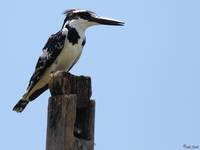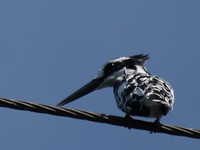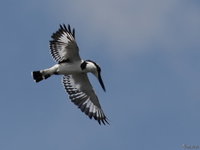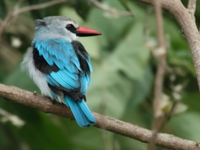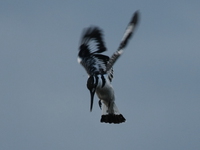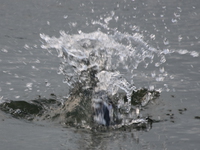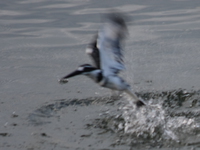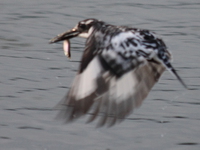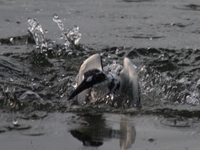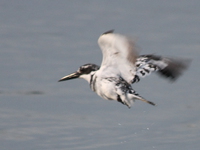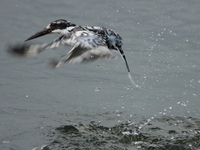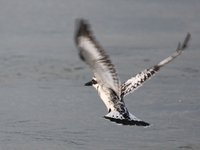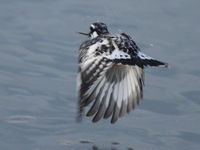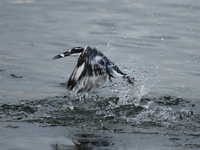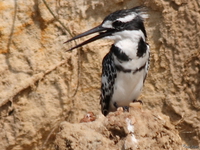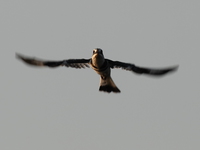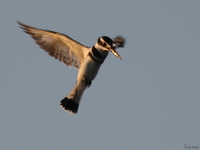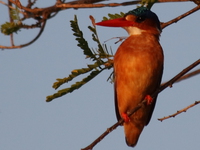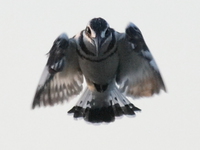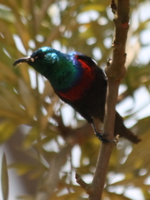kingfishers
Kingfishers are birds of the three families Alcedinidae (river kingfishers), Halcyonidae (tree kingfishers), and Cerylidae (water kingfishers). There are about 90 species of kingfisher. All have large heads, long, sharp, pointed bills, short legs, and stubby tails. They are found throughout the world.
The Pied Kingfisher (Ceryle rudis) is a kingfisher in the near passerine bird family Cerylidae, the water kingfishers. It is the only member of the genus Ceryle.
It is common throughout sub-Saharan Africa and southern Asia from Turkey to India to China. It is resident, and most birds do not migrate, other than seasonal movements.
The smallest species of kingfisher is the African Dwarf Kingfisher (Ispidina lecontei), which averages at 10.4 g and 10 cm (4 inches). The largest overall is the Giant Kingfisher (Megaceryle maxima), at an average of 355 g (13.5 oz) and 45 cm (18 inches). However, the familiar Australian kingfisher known as the Laughing Kookaburra (Dacelo novaeguineae) may be the heaviest species, since large individuals exceeding 450 g (1 lb) are not rare.
The Pied Kingfisher is estimated to be the world's third commonest kingfisher, and is a noisy bird, unmissable within its range.
It is mainly a specialist fish-eater, although it will take crustaceans and large aquatic insects. It usually hunts by hovering stationarily over the water and dives down bill first directly below to catch fish.
The pied kingfisher has evolved two unique strategies, shared by no other kingfishers. The Pied Kingfisher can hunt in both salt and freshwater. It can also deal with prey without returning to a perch, and can, for example, catch a second fish, or eat small prey in flight. These adaptations mean that this kingfisher can hunt over the sea or in estuaries that lack the perches required by other kingfishers.
This approachable largish (25cm) bird is unmistakable, with its exclusively black-and-white plumage. Unlike some kingfishers, it is quite gregarious, and forms large roosts at night. It can be easily tamed.
The pied Kingfisher's nest is a hole in a bank, on its own or in a colony, where it lays 3-6 white eggs. The pied kingfisher sometimes reproduces co-operatively, with young non-breeding birds assisting the breeding pair. As with all kingfishers, the nest of a Pied soon becomes unsanitary.
The tree kingfishers have been previously given the familial name Dacelonidae but Halcyonidae has priority. This group derives from a very ancient divergence from the ancestral stock.
Kingfishers live in both woodland and wetland habitats. Kingfishers that live near water hunt small fish by diving. They also eat crayfish, frogs, and insects. Wood kingfishers eat reptiles. Kingfishers of all three families beat their prey to death, either by whipping it against a tree or by dropping it on a stone.
The pied kingfisher was initially believed to be descended from an ancestral American green kingfisher which crossed the Atlantic Ocean about 1 million years ago (Fry & Fry, 2000). However, more recently, Moyle (2006) considered it more likely that the Pied Kingfisher and the American green kingfishers are derived from an Old World species, with the Pied Kingfisher or its ancestor losing the metallic coloration afterwards.

